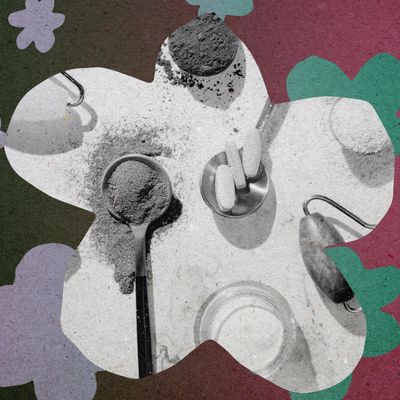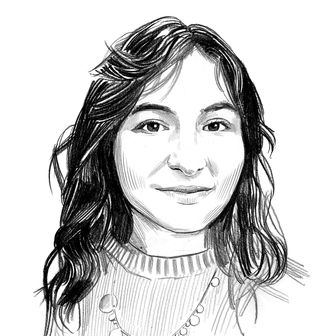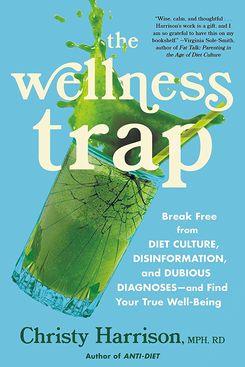
Swellness is a monthlong series exploring the health and wellness stuff no one talks about.
When I started Christy Harrison’s new book, The Wellness Trap, I expected to read about the hazards of jade rollers, juice cleanses, and maybe rectal ozone therapy. Here’s what I found instead: multilevel marketing schemes, the millennial aesthetic, QAnon, scammers, Silicon Valley, and the anti-vax movement.
To Harrison, an intuitive eating counselor and writer who published Anti-Diet in 2019, the sheer expanse of her new book is kind of the point. She portrays wellness culture as a vortex where people’s time, money, and actual well-being are subsumed by a wildly profitable industry. Its ubiquity creates so many entry points that any kind of person, including Harrison herself, can get sucked in.
Harrison’s skepticism toward the cult of wellness comes from a personal place: She spent years touting “clean” eating, organic foods, and gluten-free regimens while trying to find a diagnosis for a mysterious set of symptoms she was suffering from. The more foods she cut out in an attempt to treat herself, the worse her physical and mental health became. Years later, after training as a dietician and working with clients who’d been through similar experiences, she saw just how damaging those supposedly healthy practices had been. “That was a big eye-opener for me of how the wellness industry is driving people to disordered eating,” she says.
Harrison was far from the only person seduced and ultimately let down by wellness’s grand promises. “One of the things I hope to convey in the book,” she says, “is how slippery a slope it is.” The Wellness Trap argues that this industry — and yes, it is an industry — grew from major systemic failures like poor health care, the spread of misinformation, and the tragedy of American individualism. Her conclusions beg the question: Was it ever about our well-being at all?
To go really far back, what first made you suspect that there was something insidious about whatever we consider “wellness”?
My interaction with the wellness industry started around 2003, when I started having a lot of nebulous symptoms that the wellness industry tells you to cut out food or take supplements for. I was vulnerable to wellness-y explanations for things, so I started cutting out foods. Unbeknownst to me, I was already struggling with disordered eating at the time, and all of that stuff just made it worse: cutting out gluten, cutting out dairy, cutting out carbs.
After I became a dietician, got into good therapy, and healed my disordered eating, I was able to look back and see how the wellness industry is driving people to disordered eating. Initially I thought, What does the science actually say? If there is evidence behind this, maybe I can help people do the things they need to do and maintain some semblance of peace with food. But while researching, I found that, not only is there no evidence to support dietary recommendations for these health conditions, but some of those supposed conditions don’t exist. Many people go down these rabbit holes and become obsessed with a new supposed diagnosis, and its “cure” ends up doing so much more harm than good.
The expanse of the industry that you cover in the book is astounding. How did you decide where to start?
I started with what I knew best, which was disordered eating. My first book included a chapter about how wellness has become a modern guise for diet culture, giving it a veneer of respectability and being about health. I was curious to look at it the other way: How does wellness culture benefit from diet culture? Many people get sucked in by trying to eat “clean,” but the “clean” concept has filtered out into so many other arenas: clean beauty, clean home, clean products.
I knew I wanted to cover social determinants of health, because wellness operates on the idea that you’re in charge of your health and well-being, and it’s the individual’s responsibility to figure out what works for them. In other words, you’re responsible for doing you because nobody else is gonna help you. Socioeconomic status, race and discrimination, financial insecurity, job insecurity, food insecurity, housing insecurity — all of that plays a huge role in people’s health that’s not at all accounted for by this individualistic view. Seventy percent of population health is attributable to social determinants, and only 30 percent is individual health behaviors. Food and exercise combined accounts for only 10 percent. American individualism and capitalism fit right in with wellness culture. Our health-care system makes so many people feel dismissed and unheard, and they feel the need to take things into their own hands.
I certainly did not expect to find sections about QAnon and right-wing extremism in a book about wellness, but after reading, the connection feels clear.
I got my book deal on January 5, 2021, the day before January 6. So this idea of how social media and the internet are amplifying division and hate across society — I started looking at that as it related to wellness. The internet is driving misinformation and pulling people to the extremes of diet culture and wellness-culture content, so that became a central focus of the book.
I found myself taking note of the wellness-y language — words like clean, natural, holistic, superfoods — and how aspirational it can sound. How big a role does that language play in the industry’s allure?
That language speaks to a world that we want. There are real concerns about pollution, the pharmaceutical industry, the side effects of certain medications. The real change needs to happen at the systemic level, but getting pulled into things like clean eating or clean beauty is totally understandable when you feel like every choice you make bears the responsibility of not just your own health but the planet’s. The same goes for “holistic” and “getting to the root cause.” Conventional health care is so siloed; you can go from one specialist to another, and none of them has any idea what the other one said to you. We feel like we’re not being addressed as a whole person. Wellness culture’s promises are really appealing because we’re lacking that in our health care. They talk a good game, but I don’t think they deliver.
Wellness is largely thought of as something that the wealthy elite buy into, but your book points out that it’s often marginalized, vulnerable people who suffer from it the most. Why do you think that gets overlooked?
It’s marketed more toward wealthy people, but increasingly it’s also being marketed as, like, Everybody benefits from this. Individualism is at the core of the wellness industry: that we need to take our health into our own hands and do what the health-care system isn’t doing for us. That’s particularly harmful to marginalized groups because it ignores the social determinants of health. I think both wellness approaches and public health approaches that emphasize individual behaviors, and especially emphasize food and exercise, are really missing what’s going on, and people are being coerced and pushed into spending a large proportion of their smaller disposable income on wellness approaches.
On the flip side, as you talk about in the book, wellness is also marketed as a perpetual pursuit of peak physical well-being — a pretty convenient premise for an industry. Even those with all the time and disposable income in the world are forever striving for better “health.” Do you also see privileged people as victims of the wellness industry?
The most marginalized have the most complications and have it the worst overall, but yes, even people who can afford good health care and safe places to live are being preyed upon in some ways. I talk about Gwyneth Paltrow and how she’s profiting off wellness culture and spreading harmful messages about wellness and anti-science, but she’s also a victim. There’s pressure on her to look a certain way to maintain youth and conventional beauty and thinness, and I think she’s a victim of that as much as many people are, even while perpetuating it and profiting from it.
I also got the sense a lot of the wellness industry is designed to prey on women — there’s so much female-coded marketing, like with MLM huns or pastel QAnon.
I hear from people across the gender spectrum about the pressures they face to look a certain way, but I think wellness culture really hooks women for a number of reasons that are all connected. Women are historically underserved by the conventional health-care system and disproportionately affected by a lot of illnesses that don’t have great evidence for treatment. Conditions like chronic fatigue and endometriosis have been historically contested and therefore under-funded. There’s also Western Eurocentric beauty ideals, which make the pressures on women so extreme. It’s not just pressure to be thin, but also to look organic and clean and like you’re using the “right” skin care. There’s pressure on mothers to feed their children the perfect way, look a certain way after giving birth, breastfeed, etc. The way that femininity is sold in these wellness spaces is increasingly overt.
You also talk briefly about biohacking and this toxic masculine brand of disordered eating. How does the wellness industry affect people across the gender spectrum?
There’s increasingly unrealistic body ideals for men, too, like superhero culture. The biohacking, tech-bro diet culture has that same foundation of body ideals, denigrating conventional medicine and lionizing individual approaches. I see these types dominating the podcast charts, advocating the monitoring and tracking of all these different bodily functions in a way that’s so intellectualized and takes you away from being in your body and feeling your body. It’s built on this traditional idea that men are logical and patriarchal — maleness as being sort of rational.
Some people also feel pushed to lose weight and shrink their bodies in order to escape perceived gender ideals. One therapist I spoke with pointed out that alternative-medicine spaces are sometimes more welcoming to trans and nonbinary folks and queer folks, because conventional health care can be pretty unaccepting of their bodies. There’s this sense of empathy and acceptance from the start that can make wellness approaches feel safer for people who are trans and nonbinary. But these are such unregulated spaces and can promote harmful practices.
There’s some discussion now that we’re going back to talking about thinness much more openly and explicitly instead of veiling it under wellness culture. How do you think the wellness industry will adapt to that?
In anti-diet spaces, there’s a lot of critical thinking about how that cultural shift is happening and what’s driving it. It will be interesting to see if there’s a branching off of wellness culture opposing those drugs and saying, “We won’t put anything pharmaceutical in our bodies, even if we need to lose weight.” But wellness culture has been built around the thin ideal for a long time. I don’t think it’s going to diverge that much. Maybe there will be a little more overt acknowledgment of weight loss now, if these diet drugs make it okay again to say that part out loud, but I also think you can just go on with the coded language and it’s still the same thing.
More From This Series
- Things We Tried and Would Use Again
- I Tried It: Estrogen Face Cream
- What to Do (and Not to Do) When Your Friend Has a Newborn






